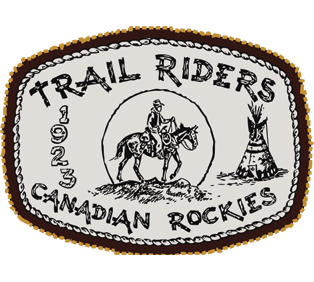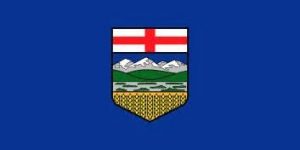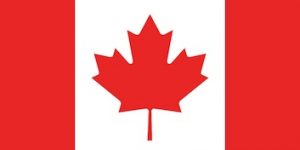History
Historical Highlights of the Trail Riders of the Canadian Rockies
Historical Highlights of the Trail Riders of the Canadian Rockies
By Michelle Tilly
(Revised 2014 and 2017 by S. R. Watkins)
The Founding Four Fathers…
The history of the Trail Riders of the Canadian Rockies dates back to 1923. The Rockwall area in Kootenay National Park had little historical significance were it not for a 1923 gathering that took place along the trail. In August 1923 Dr. John Murray Gibbon organized a fishing trip along the Columbia River. As chief publicist for the Canadian Pacific Railway (CPR) Gibbon had a number of “friends in high places.” The adventurers he assembled for the trip included Reginald Townsend, editor of Country Life in America magazine, and his wife, Madeline Drexel Townsend; Harry Beach Clow, President of the Rand McNally Map Company and his wife, Elizabeth Clow; famous Chicago artist Reinhold Heinrich Palenske and his wife, Eva Helen Palenske; H. Armstrong Roberts; Byron Harmon, photographer and official photographer for the Alpine Club of Canada; Walter Nixon, an outfitter and guide from the Windermere region, outfitted the party and brought along his friend, Madeline Turner. They traveled from the Kootenay River to the Wolverine Plateau near Tumbling Glacier, probably along the Beaverfoot River and up Dainard Creek to Wolverine pass. A snowstorm on the plateau confined them to their tents for three days. Though no doubt discouraged by the delay, the group took full advantage of their enforced break to set their imaginations free. These experienced travelers found the ride along the Rockwall to be the most scenic they had ever taken. Far from wishing to keep such experiences to themselves, they believed that recreational riders should have regular opportunities to participate in such trips. The result of their discussion was the founding of, “The Order of the Trail Riders of the Canadian Rockies.”
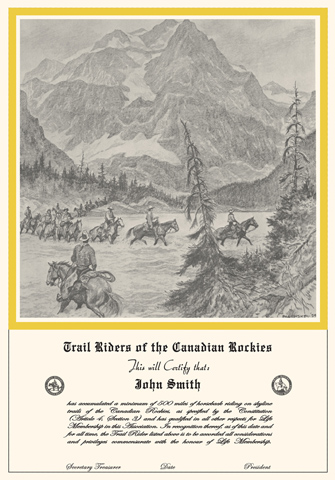 The founding four (Gibbon, Clow, Palenske, and Townsend) felt that a prominent executive committee would give the group credibility and provide the momentum needed to launch it. When Gibbon returned to Montreal he set about convening just such a committee. To help provide a draw for its hotels at Banff and Lake Louise, the CPR sponsored not only the Trail Riders, but later, sister organizations, the Skyline Hikers and the Banff Ski Runners and set about advertising the “Order” worldwide. Dr. Charles Walcott, secretary of the Smithsonian Institution in Washington, was asked to serve as President and H.B. Clow, Vice President. Gibbon himself took on the role of secretary-treasurer, a position he held for the remainder of his active life. His role at the CPR insured strong financial support to the trail riders. “The Council,” an advisory committee, consisted of J.B. Harkin, Commissioner of Dominion Parks; W. T. Hornaday, Director, New York Zoological Society; Sir James Outram, a noted mountaineer (who made the first ascent of Mnt. Assiniboine); Carl Rungius, a wild life artist from Banff and New York; Mary Vaux Walcott, Mary Schaffer a local botanist and explorer; Jim and Bill Brewster, Jim Simpson, and Bill Potts all of whom were outfitters.
The founding four (Gibbon, Clow, Palenske, and Townsend) felt that a prominent executive committee would give the group credibility and provide the momentum needed to launch it. When Gibbon returned to Montreal he set about convening just such a committee. To help provide a draw for its hotels at Banff and Lake Louise, the CPR sponsored not only the Trail Riders, but later, sister organizations, the Skyline Hikers and the Banff Ski Runners and set about advertising the “Order” worldwide. Dr. Charles Walcott, secretary of the Smithsonian Institution in Washington, was asked to serve as President and H.B. Clow, Vice President. Gibbon himself took on the role of secretary-treasurer, a position he held for the remainder of his active life. His role at the CPR insured strong financial support to the trail riders. “The Council,” an advisory committee, consisted of J.B. Harkin, Commissioner of Dominion Parks; W. T. Hornaday, Director, New York Zoological Society; Sir James Outram, a noted mountaineer (who made the first ascent of Mnt. Assiniboine); Carl Rungius, a wild life artist from Banff and New York; Mary Vaux Walcott, Mary Schaffer a local botanist and explorer; Jim and Bill Brewster, Jim Simpson, and Bill Potts all of whom were outfitters.
Editor’s note: We are very grateful to Mr. Emerson Sandford who gave us permission to update our information with the preceding two paragraphs with more accurate information. After twenty years of research and hiking every trail in the mountain National Parks, Mr. Sandford has written “Life on the Trail,” an eight volume historical series about the trails of the backcountry of our mountain National Parks. Copies are available from: emsanf@telus.net Thank-you Mr. Sandford for preserving our Canadian history!
This interim executive was charged with organizing the first official ride to be held in 1924, and the first annual meeting to be known as the “Pow-Wow” (an Algonquin word meaning “get together”). The Yoho Valley was chosen for this first Pow Wow because of its accessibility as well as for its majestic beauty. With the co-operation of the CPR, the accommodations at the Bungalow Camp at Takakkaw Falls were supplemented with twenty Indian teepees and a large circular tent decorated in Indian fashion as a Sundance Lodge. The decoration of the Sundance Lodge was completed by Chief Walking-in-the-Road of the Stoney Indians, assisted by two artists of his tribe whose skill and speed astonished not only the army of photographers on site, but also the noted artists in attendance. Two hundred and seven enthusiastic people attended the first Pow Wow. To mark such a notable occasion, a bronze plaque of Tom Wilson one of the outstanding guides of the Canadian Rockies, had been prepared. Modestly, Tom at first refused to be present at the unveiling, but upon receipt of a telegram from Jim Brewster that read, “Get here if you have to break your neck,” Tom took the train from Enderby, B.C. Tom’s response to the welcoming speeches of Col. Phil Moore and Mrs. Walcott was brief and to the point: “I am not accustomed,” he said, “to extemporaneous speaking unless a cayuse has stepped upon my foot.”
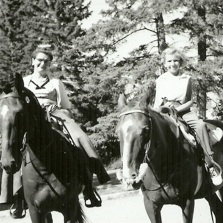
The early outfitters and founders of the TRCR saw the Indian Sundance Lodge at Takakkaw Falls, and they “put their heads together” and thought it would be great to have one of those in trail ride camp. A design was created, the canvas stitched together, and for 90 years now we have been packing in our own “Doughnut” tent to every one of our camps. Today you can see an example of an authentic “Sundance Lodge” at the Luxton Museum in Banff.
The Doughnut is a round canvas tent, 36 feet in circumference with walls that are 5 feet high supported by 32 posts. At that point, a canvas roof, set at about a 45° angle and supported by 12, 18 foot poles, runs from the top of the posts towards the middle of the round walls. It stops short leaving a six-foot “hole,” (hence the term “doughnut” or “donut”.) Each evening in camp we light a bonfire in the middle of the Doughnut and the smoke appropriately goes out the “hole” in the roof. Our “creation” unique to the TRCR has been copied by our sister organization the Skyline Hikers, and many other outfitters as well.
Buttons, Teepees, and Music
Another idea broached on Wolverine Pass was to make available “buttons” or “pins” to distinguish the number of miles a rider had ridden in the National Parks. R.H. Palenske, one of the original “founding four” designed the buttons with a slight difference for men and women; the men’s have the horse standing straight and the ladies horse is eating grass. Many people earned their 2500 mile pins in those early days. A list published three months after the first official ride includes 53 of them; there were 97, 2500-mile pin holders by 1927. An early Bulletin relates that, “By 1947, over 2000 riders had attended one or more 5-day rides.” Later Mr. Palenske designed the life membership certificate which is still in use today (completion of seven rides is required.)
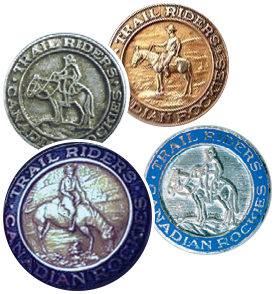 Although a Trail Rider is embossed on the buttons, the most recognized and unique symbol of the TRCR is the teepee. It was natural for the CPR to use teepees rather than tents as the magnetism of the Indians in their colourful beaded buckskin regalia and their colourful “teepee towns” attracted tourists to them. The Stoney Indians made Gibbon a chief in 1944 and conferred on him the title of “Chief-Man-of-Many-Sides.” Indian artists painted the TRCR teepees until about 1950. After that the new teepees were plain white, but the white canvas just didn’t seem right, so Bunny Robinson, a talented artist and longtime Trail Rider, was asked to take over the job of painting them. According to Bunny, “The task of applying appropriate design to an inspiring circle of these dwellings that hold such a feeling of adventure and anticipation to any true Trail Rider upon his first glimpse of camp poses quite a problem. It just didn’t seem right not to use traditional Indian design, and if Indian design, why not “authentic” Indian design. Since our members come from so many scattered geographical points, why not expose them to some of our true Western culture; and so my hunt began for traditional history and authentic design. This became more involved, more interesting, and more rewarding as I went along, until I found myself embarked on a new adventure and experience, adding every moment to my respect and admiration for our friends the Indians. After one becomes familiar with the various Indian legends and symbols, it is an adventure to evolve designs, and I have quite a number of ideas sketched for more teepees in the future.”
Although a Trail Rider is embossed on the buttons, the most recognized and unique symbol of the TRCR is the teepee. It was natural for the CPR to use teepees rather than tents as the magnetism of the Indians in their colourful beaded buckskin regalia and their colourful “teepee towns” attracted tourists to them. The Stoney Indians made Gibbon a chief in 1944 and conferred on him the title of “Chief-Man-of-Many-Sides.” Indian artists painted the TRCR teepees until about 1950. After that the new teepees were plain white, but the white canvas just didn’t seem right, so Bunny Robinson, a talented artist and longtime Trail Rider, was asked to take over the job of painting them. According to Bunny, “The task of applying appropriate design to an inspiring circle of these dwellings that hold such a feeling of adventure and anticipation to any true Trail Rider upon his first glimpse of camp poses quite a problem. It just didn’t seem right not to use traditional Indian design, and if Indian design, why not “authentic” Indian design. Since our members come from so many scattered geographical points, why not expose them to some of our true Western culture; and so my hunt began for traditional history and authentic design. This became more involved, more interesting, and more rewarding as I went along, until I found myself embarked on a new adventure and experience, adding every moment to my respect and admiration for our friends the Indians. After one becomes familiar with the various Indian legends and symbols, it is an adventure to evolve designs, and I have quite a number of ideas sketched for more teepees in the future.”
Images on the Sundance Lodge depict stone rubbings taken from rock carvings created by the Indians in Writing-On-Stone Park, Alberta, as far back as the 1700′s. Permission to recreate the rubbings was given to Bunny in the 1960’s. Over the years, Bunny, whose first Trail Ride was in 1942, has painted designs on about fifty teepees as well as the Doughnut tent. She passed away in the 80’s. Although we are the only riding organization to greet you with teepees at the end of the trail on the first day, changes in Parks’ policies through the years have eliminated all open fires in them. Since there is wear and tear from the riders and the elements, the teepees must be replaced after about eight years. A Teepee Fund exists to provide for this replacement. Contributions to this fund are very much welcome!
Music has played an important part in our history since the beginning. At the first Pow Wow in 1924 a piano was hauled up from the trailhead to Takakkaw Falls. In subsequent years a portable organ survived fifteen years before a second organ was bought. In 1944 a third organ was finally hurled over a precipice in frustration by the packers led by Soapy Smith, however John Murray Gibbon retrieved the pieces and got it working again. Shortly after, the packers again hurled it, this time to its demise in Og Lake, north of Mnt. Assiniboine. (Editor’s note: see the feature story about Soapy Smith in the 2018 TRCR Bulletin.) Since then we have relied on more portable instruments including guitars, accordions and fiddles for our entertainment. One of our most well-known musicians was Wilf Carter who had been a packer. At Gibbon’s suggestion, Carter came on his first Trail Ride as musician in 1932, strumming his guitar along the trail. In 1933 he was made “Official Musician,” and thus began his career under the name of “Montana Slim” (Editor’s note: see a full story about Wilf Carter in our spring 2014 Bulletin.) Later Clarence Richards, Allen Crawford, Dora Kirk, Don Watkins, Dennis Orr and Stuart Watkins were all “official musicians.” The musical tradition continued, thanks largely to Gibbon’s enthusiasm for putting together a TCRC song book. Since, then there have been five more editions and the sixth one was produced in the spring of 2013 for our 90th anniversary.
Many of the TRCR song parodies in our song books were written by Graham Nichols who was the Director of Public Relations for the Canadian Pacific Railway, the TRCR’s sponsor from 1923 – 1962. Graham lived in Toronto and brought his executive friends and CPR buddies (aka “city dudes”) on a ride every summer. Graham was famous for hosting “over-crowded teepee parties” where excessive amounts of “Oh be joyful” (alcohol) was served. Some of these songs were written during that time frame, the 1940’s and 50’s, no doubt during a teepee party. Examples have been re-printed in our current anniversary songbook. Over the last 50 years, numerous people have contributed to these various editions and the Board of Directors, wishes to acknowledge and thank them for their tireless efforts: Howard Watkins, Dennis Orr, Al and Romana Owcher, Shel and Cylia Bercovich, Sandra Yates, Lori and Lloyd Rotz, Pat Allen, Rick Godderis, Ben Bury, Janina Hoyne, and Dave Keller, and Stuart Watkins.
Although the TRCR had an official photographer in the early days, Reginald Townsend, one of the group stranded by the weather in Wolverine Pass in 1923 donated the Townsend Trophy to be awarded yearly to the best amateur photograph taken on the trail (As Editor of Country Life of America magazine he also gave much publicity over the years to the TRCR). The Townsend Trophy Annual Photography competition is a TRCR tradition and like our mileage buttons, continues today. The splendid silver Trophy is on display at the Annual General meeting and the winners receive an engraved plaque. Since the founding of the Townsend Trophy in 1929, incredibly beautiful trail ride photos have been reproduced in various magazines, brochures and newspaper articles. In 1943 we had our first visitor from the Canadian Broadcasting Corporation on a Trail Ride. This was followed in 1946 by photographers from the National Geographic and Time Magazines. In 1948 the TRCR was featured in its first movie, “Trails in The Rockies.” This was followed in 1953 by a Fox-Movie-tone cinemascope short and in 1955 by a C.P.R. movie “Riding High” shown internationally on TV. Media coverage has continued, including a video special and magazine articles celebrating our 60th Anniversary in 1983 and a write-up in “The Western Horseman” magazine in 1968.
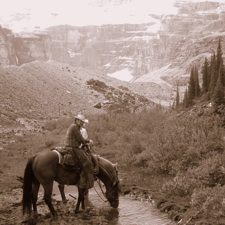 Royalty has ridden with us too! In 1931 King Prajadhipok of Siam and his Queen were staying at the Banff Springs Hotel and heard about the Trail Riders of the Canadian Rockies. Intrigued, they discovered that if they rode at least 50 miles they would be eligible for a pin. (at that time Trail Riders did not have to ride on the official Trail Ride to be eligible.) So the King of Siam, over the protests of his advisors, earned the Silver pin for riding 100 miles and his Queen, a Bronze pin for 50 miles. Subsequently, the King and Queen became life memberships in the TRCR Needless to say, later TRCR visitors to Siam were greeted royally! Other famous celebrities that have joined us include Andy Russell, the famous cowboy, rancher, author, and grizzly bear expert. (Editor’s Note: See our spring 2106 bulletin for a story about the guide who rode with the King and Queen of Siam.)
Royalty has ridden with us too! In 1931 King Prajadhipok of Siam and his Queen were staying at the Banff Springs Hotel and heard about the Trail Riders of the Canadian Rockies. Intrigued, they discovered that if they rode at least 50 miles they would be eligible for a pin. (at that time Trail Riders did not have to ride on the official Trail Ride to be eligible.) So the King of Siam, over the protests of his advisors, earned the Silver pin for riding 100 miles and his Queen, a Bronze pin for 50 miles. Subsequently, the King and Queen became life memberships in the TRCR Needless to say, later TRCR visitors to Siam were greeted royally! Other famous celebrities that have joined us include Andy Russell, the famous cowboy, rancher, author, and grizzly bear expert. (Editor’s Note: See our spring 2106 bulletin for a story about the guide who rode with the King and Queen of Siam.)
The Golden Years of Trail Riding
Just as Hollywood had its “golden years” so did the TRCR The marketing strategy during the 40’s and 50’s was to travel west on a CPR train, stay in a CPR hotel (The Banff Springs) and go on a CPR trail (TRCR). Many “colourful characters” arrived each year from the wealthier areas of eastern Canada and the U.S.A. – Marshall Diverty from New York State, “Prof” Davis from California, Graham Nichols from Toronto and Lib Smith from Pennsylvania. Nichols was the “P.R.” man for the CPR (succeeding John Murray Gibbon) and he arrived each summer by train with a group of “executive city slickers” from the corporate offices of the CPR in Montreal (now in Calgary). Lib Smith operated a “finishing school” for girls in Pennsylvania and brought a group of teenage girls known as “Lib’s harem” on the rides each summer. There were so many U.S. riders, that the President of the “Order of the Trail Riders of the Canadian Rockies” alternated each year between a Canadian President and a U.S. one. This practice continued until 1971 when it was dropped as a matter of practical operations.
The near Demise and Resurrection of the Trail Riders
With the advent of commercial air travel and other financial issues, in early in 1961, the CPR notified all riders and hikers that it would no longer sponsor the associations because of the financial burden. At the end of the 1961 Trail Ride season, the CPR transported the equipment back to the Banff Springs Hotel where the manager announced everything was going to be auctioned! This aroused the wrath of Howard Watkins, a rider since the early 1950’s, who wrote to Norris “Buck” Crump, President of the CPR who was also a past Trail Ride President. Mr. Crump replied quickly that the CPR would sell all the equipment to the T.R.C.R. and the Skyline Hikers for $1.00.
As the demise of the TRCR would have been a terrible blow to the membership, a group of Calgarians, under the leadership of Howard and Bunny Robinson, and Lou Schulman with Mary Lore of the Skyline Hikers, decided to maintain the organizations and established independent non-profit associations. Jack Waite and Earl Lomas provided the legal assistance and Claude Brewster, the outfitter for both groups, agreed to carry on for 1962 as 80 riders had already registered as well as numerous skyline hikers. Howard became the first President of the new TRCR as a non-profit and was on the board of directors for fifteen years. The club started with the equipment (all stored in Howard’s basement) and $50.00 in the bank. With tremendous effort the two organizations were rescued from their threatened demise. After years of hard dedicated work by this second group of “four founders” (Howard, Bunny, Jack and Earl) the TRCR not only survived, but flourished.
The Fiftieth Anniversary of the Trail Riders of the Canadian Rockies, was celebrated at the end of the first ride of 1973 with a “super Pow-Wow” at the Indian Days grounds in Banff. The barbecue was capably handled by Annette and Bud Brewster, who had been the TRCR’s outfitter for many years before selling the horse part of their operation to Ron Warner and Mac Mackenzie. Third time President Howard Watkins was honoured for keeping the organization going and for attending one to three rides per year during the past twenty years (he Emceed all four rides one year as he could not entice anyone else to be an Emcee!)
1983 marked the Jubilee Celebration of Trail Riding with a Sixtieth Anniversary Ride. Wally Jamieson spear-headed the work of Dorothy Lomas, Dennis Orr and dozens of other volunteers. On September 10th, after a breakfast with friends and Park personnel at the Banff Springs Hotel and a parade through Banff, sixteen riders headed north for Jasper. On the same morning fourteen riders left Jasper headed south for Banff. After eight days on the trail, the two groups met with about 200 long-time Riders for a Pow-Wow on the Kootenay Plains beside the North Saskatchewan River. Trail Riders of all ages ascended, many with their families. Former outfitters, staff, musicians, Parks Canada officials, and various dignitaries also appeared for the reunion. Mary Dover (nee Cross), who first rode with the Trail Riders in 1927, was guest of honour. Presentations were made to Fred Laidlaw, the last CPR Secretary-Treasurer; Don Harmon, son of Byron Harmon, represented the photographers; Bud Brewster, represented all the outfitters; Dora Kirk, represented the musicians; and Esther Richards (a long time TRCR cook), represented all the wonderful cooks. Barbecued steaks grew cold while the hugging, kissing, visiting and dancing continued long into the night. Bright and early the next morning, the two groups of riders once again headed through sun and snow for Banff or Jasper, to continue the celebration of Alberta’s heritage.
Many changes have taken place over the years within the Parks and Teepee Town. From 1924 through 1945 there was one ride every summer, usually in late July, with approximately 65 riders. This moving ride found a new camp every evening. During the war years of the 40′s, it was decided that a stationary camp would better suit the organization, the outfitters, and the environment. (not to mention that the riders and their duffel were separated one year as a result of a snow storm!)
The Golden Years again…
The “golden years” of the TRCR repeated themselves during the 70’s and 80’s as the club grew to eight, six day rides, which were usually full every summer with as many as thirty-five riders. The TRCR is indebted to the many wonderful “outfitter staff” that came back and worked on the rides year after year. Mike Crawley (originally from South Africa) with his warm and funny personality and a twinkle in his eye, was our head guide for seventeen summers. Others included: Dan Heather, Steve Goertz, Colin Smith, Gord Thompson, Stuart Watkins, Del Brassard, Dennis Orr, “Nice Ron” Pruden, Roy Yano, “Cloudy” (a university professor of English from Ontario!) Bob Langridge, and Bob Lamone. Our outfitter for thirty-five consecutive years was Ron Warner of “Holiday on Horseback” who we are indebted to for helping to keep us going through some lean years and who helped with negotiations with Parks Canada. We express our gratitude and thanks to all these wonderful employees.
The Annual Calgary Spring Round-Up commenced in 1963 and is still eagerly anticipated each year. It is a time to meet riders not seen since the previous summer, do a bit of reminiscing and enjoy a nice dinner. It is also an encouragement to register for ride for the coming season! In the 70’s and 80’s Dr. Bruce Hatfield was famous for showing his annual “Hatfield’s three ring circus” at the Round-up in the basement auditorium of the Canadian Western Natural Gas building in downtown Calgary. His “circus” consisted of a movie shot of last summer’s trail ride with slide projectors operating each side of the movie screen, all showing pictures simultaneously with Bruce’s funny commentary! During the 1980’s there was a Fall Round-Up at the acreage of long time trail riders, Barb and Frank Wotypka’s in Sherwood Park, AB. There was a huge barbecue, with square dancing, and reminiscing with the tales of the summer’s rides. Barb passed away a number of years ago, and Frank in the spring of 2013.
For the first thirty years of the TRCR’s existence as a non-profit, a medical doctor accompanied each ride which was coordinated by the late Dr. Bruce Hatfield. With the advent of modern technology (communications, satellite telephones and air ambulances) the position of medical doctor was eventually eliminated. The TRCR is grateful to all those doctors who served in this capacity.
One more group of individuals that the TRCR is indebted to is our long list of Secretary-Treasurers. Although this was (is) a paid position, the staff were never paid enough for their hours of dedicated service. We are indebted to: John Murray Gibbon, Fred Laidlaw, Howard Watkins, Mary Lore, Muriel Walters, Laura-May Dennis, Linda Stewart, Barbara Hensen, Marleen Lee, Penny Edgeland, Michelle Tilly, Kevin MacDonald and our current Secretary-Treasurer, Robert Vanderzweerde. We also acknowledge Sol Lipkind who stored our equipment and housed our offices at no charge for numerous years. We are indebted to Fairbanks Morris in Cochrane, Alberta who have graciously stored our equipment year after year at no charge, and now to Joel Lipkind who continues the tradition of storing our equipment at no charge. Ted Watchuck has transported our gear from storage to trail head/camp and back for several years. Many thanks…
New Polices; forever changing the T.R.C.R.
Since the mid 90’s the TRCR has had to change as the world has changed; different demographics have changed our ridership; the economy, changing tourism trends, and restrictions from Parks Canada etc. The club has not been able to continue its rotation of campsites inside the Banff National Park and the club had to go to other mountainous areas outside of the Park and use other outfitters. However, with the determined perseverance of the Board of Directors, the TRCR continues to operate as a not-for-profit as it has for over fifty years with five volunteer board members. Without their hard work and dedication, the TRCR would have folded in 1961, and many other times since then.
In the mid 1990’s Rick Godderris, a dedicated trail rider assumed the position of President and secretary-treasurer and single handedly keep the club going. To those that have served, we this next generation of trail riders are most grateful and offer our sincerest thanks to: Howard Watkins, Bunny Robinson, Jack Waite, Earl Lomas, Jack Petrie, Sol Lipkind, Barb Rostrom, Barb and Frank Wotypka, Wally Jamison, Lois Laycraft, (all deceased) Pat Allen, Dennis Orr, Joel Lipkind, Terry Stowell, Rick Godderris, Gord Thomson, Dennis Welham, Ben Bury, Kevin MacDonald, Gary Sandbeck, Stuart Watkins and many, many more.
A milestone was reached in the spring of 2014. The trail riders long time outfitter, Ron Warner, sold his business, Warner Guiding and Outfitting Ltd. after 52 years of operations. Ron was very supportive of the TRCR for many years and we are most grateful to him for that. A happy and well deserved retirement Ron! The “Warner reins” are now owned by Julie Canning are Jonathon Welsh. A retirement/reunion was held for Ron on October 4th, 2014 and TRCR President Stuart Watkins presented him with several gifts including a TRCR Honourary Life Membership. Happy Trails Ron!
With declining membership and 3/4 of the board resigning in September of 2014, the TRCR was left with Stuart Watkins and Gary Sandbeck at the helm and no secretary-treasurer. Fold or continue? Judy Fleetham attended her first ride that summer and loved it so much she agreed to join the board. With Stuart as President and Gary V.P., the “board” of three hired Robert Vanderzweerde as the new secretary-treasurer. Robert has been invaluable to the club and the team has pulled the TRCR out of near bankruptcy.
In 2015, the TRCR returned to Waterton Lakes National Park, but to new areas within the Park and also used a non-wilderness camp for the very first time, as a trial. It was a very successful summer, so much so, that by popular demand we had a four-year contract with our new outfitter, Deb Watson owner of Alpine Stables. We were very pleased to see Deb, her Dad Dee Barrius (the cowboy legend of Waterton) and their amazing family adopting the high standards of excellence that the TRCR has been proud of for over 90 years.
Since 2018, the Trail Riders has returned to the backcountry, working with various outfitters such as Banff Trail Riders (Julie Canning and Jonathon Welsh), Boundary Ranch (Rick, Haylie and Jonas Guinn), and Anchor D Ranch (Dewey & Sue Matthews) to ride into the Cascade Valley, to Halfway Lodge, into Happy Valley and to the Little Elbow River, along the Great Divide and more.
One of the objectives of the original constitution of our Society states in part: “To encourage travel of horseback through the Canadian Rockies and to foster the maintenance and improvement of old trails and the building of new trails.” With the increased use of all Park facilities in recent times, it is noteworthy that this part of our constitutional objective is still being honoured. The TRCR maintains an excellent environmental stewardship record with Parks Canada. National Parks policy allows only three not-for-profit organizations to have semi-permanent camps in Banff National Park: The Skyline Hikers of the Canadian Rockies, the Alpine Club of Canada, and the TRCR. From its camps, the Trail Riders of the Canadian Rockies seek a new and exciting adventure each day. Additionally, our goal is to educate, maintain, and foster western Canadian history and western cowboy culture. We do this with various educational programs and social events.
100th Anniversary
Can you believe it? 2023 is the 100th Anniversary since the founding of the Trail Riders in 1923.
We’re working on a museum exhibit (starting June 18), a round-up (September 24), writing a book, creating a CD, recording a new documentary, and much more. There’s even a special ride planned for 2023 in Banff National Park …
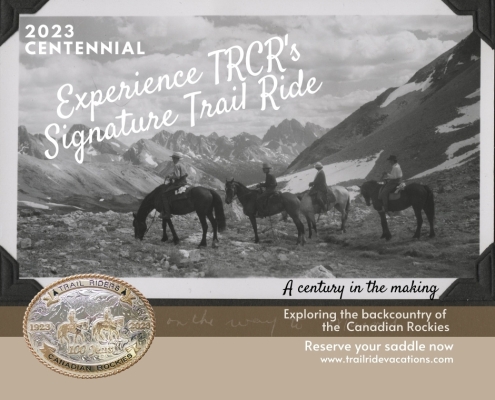
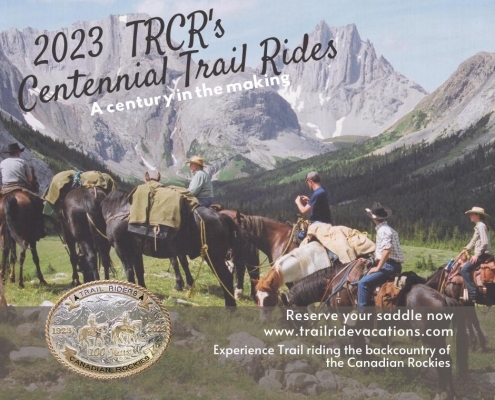
Watch our website and Facebook for announcements for the round-up.
There is also merchandise available …
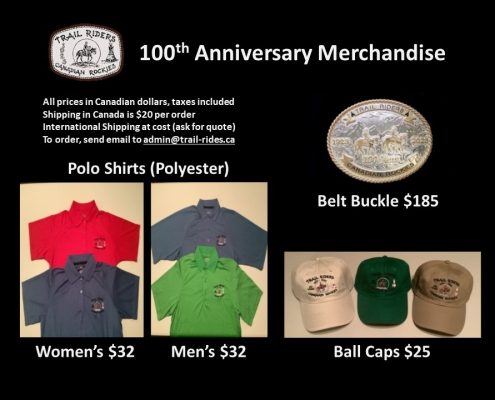
Come Ride with Us!
Book now for our upcoming ride or contact us for more information.
| Presidents under the sponsorship of the Canadian Pacific Railway | |||
|---|---|---|---|
| Year | President | Residence | Ride Location and Outfitter |
| 1923 | First ride | Wolverine Pass (W. Nixon) | |
| 1924 | Dr. Charles Walcott | Washington D.C. | Takakkaw Falls (W. Nixon) |
| 1925 | W. W. Foster | Vancouver, British Columbia | Marble Can. – Mtn Goodsir (W. Nixon) |
| 1926 | J. M. Wardle | Banff, Alberta | Baker Lake (W. Nixon) |
| 1927 | J. M. Wardle | Banff, Alberta | Mnt. Assiniboine (W. Nixon) |
| 1928 | J. M. Wardle | Banff, Alberta | Horse Thief Creek area (W. Nixon) |
| 1929 | Carl Rungius | Banff, Alberta and New York, N.Y. | Sunshine – Shadow Lake (W. Nixon) |
| 1930 | Walter Wilcox | Banff, Alberta and Washington D.C. | Shadow Lake – Floe Lake (W. Nixon) |
| 1931 | Walter Wilcox | Banff, Alberta and Washington D.C. | Stoney Creek – Flints Park (W. Nixon) |
| 1932 | Lt. Col. Philip A. Moore | Banff, Alberta | Mnt. Assiniboine (W. Nixon) |
| 1933 | James Brewster | Banff, Alberta | Molar/Dolimite Pass (J. Brewster) |
| 1934 | Pearl Moore | Banff, Alberta | Wolverine Pass (J. Brewster) |
| 1935 | George Vaux | Pennsylvania | Banff – Red Deer – L. Louise (J. Brewster) |
| 1936 | George Vaux | Pennsylvania | Johnston Creek (J. Brewster) |
| 1937 | R. H. Palenske | Chicago, Illinois | Mnt. Assiniboine (C. Brewster) |
| 1938 | R. H. Palenske | Chicago, Illinois | Healy Pass (C. Brewster) |
| 1939 | Dr. C. W. Prowd | Vancouver, B.C. | Sunshine to Moraine Lake (C. Brewster) |
| 1940 | Dr. C. W. Prowd | Vancouver, B.C. | L. L. – Goodsir – Marble Can. (C. Brewster) |
| 1941 | William Bardwell | Chicago, Illinois | Mnt. Assiniboine (C. Brewster) |
| 1942 | H. J. Coleman | Vancouver, British Columbia | Cascade – Lake Louise (C. Brewster) |
| 1943 | Marshall Diverty | Woodbury, New Jersey | Simpson Pass – Fatigue Pass (C. Brewster) |
| 1944 | Dr. A. J. Gillespie | Fort William, Ontario | Fatigue Pass – Simpson Pass (C. Brewster) |
| 1945 | Keith Hoffmeyer | Indianapolis, Indiana | Baker Lake/Ptarmigan Lake (C. Brewster) |
| 1946 | George Rea | Saskatoon, Saskatchewan | Panther River (C. Brewster) |
| 1947 | Sidney Hollander | Baltimore, Maryland | Healy Creek (C. Brewster) |
| 1948 | Harold Price | Calgary, Alberta | Simpson Pass (C. Brewster) |
| 1949 | Ralph Mather | St. Paul, Minnesota | Pipestone/Skoki (C. Brewster) |
| 1950 | Fern Brewster | Banff, Alberta | Palliser Pass (C. Brewster) |
| 1951 | Eaton Cromwell | New York, New York | Wolverine Pass (C. Brewster) |
| 1952 | Jock Smith | Vancouver, British Columbia | Egypt Lake (C. Brewster) |
| 1953 | Dr. H. J. Vanek | Vancouver, British Columbia | Baker Lake/Ptarmigan Lake (C. Brewster) |
| 1954 | Charles McDunn | Regina, Saskatoon | Mnt. Assiniboine (C. Brewster) |
| 1955 | C. S. McNair | Great Falls, Montana | Johnstons Creek (C. Brewster) |
| 1956 | Charles Douglas | Calgary, Alberta | Pipestone River (C. Brewster) |
| 1957 | LaVera Fuerst | Cincinnati, Ohio | Panther River (C. Brewster) |
| 1958 | N.R. (Buck) Crump | Montreal, Quebec | Bryant/Mnt. Assiniboine (C. Brewster) |
| 1959 | Dr. Dorothy Muirhead | Hastings, Minnesota | Palliser Pass (C. Brewster) |
| 1960 | Don McVeigh | Drumheller, Alberta | Pipestone River (C. Brewster) |
| .
Presidents Under an Incorporated Non-Profit Society |
|||
| Year | President | Residence | Ride Location/Outfitter |
| 1961 | Howard Watkins | Calgary, Alberta | Mnt. Goodsir (C. Brewster) |
| 1962 | Howard Watkins | Calgary, Alberta | Pipestone River (C. Brewster) |
| 1963 | Bunny Robinson | Calgary, Alberta | Healy Creek (C. Brewster) |
| 1964 | Earl Lomas | Calgary, Alberta | Bryant/Mnt. Assiniboine (B. Brewster) |
| 1965 | R. W. Davis | Berkley, California | Palliser Pass (B. Brewster) |
| 1966 | Jack Waite | Calgary, Alberta | Ptarmigan Valley (B. Brewster) |
| 1967 | Jim Kincaid | Oakland, California | Palliser Pass (C. Brewster) |
| 1968 | Jack Petrie | Calgary, Alberta | Mnt. Assiniboine (B. Brewster) |
| 1969 | Howard Quinlan | Indianapolis, Indiana | Johnston Creek (B. Brewster) |
| 1970 | Lois Laycraft | Calgary, Alberta | Healy Creek/Sunshine (B. Brewster) |
| 1971 | David Lamphre | Fullerton, California | Pipestone River (R. Warner) |
| 1972 | Sol Lipkind | Calgary, Alberta | Shadow Lake (R. Warner) |
| 1973 | Howard Watkins | Calgary, Alberta | Palliser Pass (R. Warner) |
| 1974 | Norman Bell | Gormley, Ontario | Johnston Creek (R. Warner) |
| 1975 | Dennis Orr | Calgary, Alberta | Pipestone River (R. Warner) |
| 1976 | Dennis Orr | Calgary, Alberta | Cascade Valley/Mystic Lake (R. Warner) |
| 1977 | Dorothy Lomas | Calgary, Alberta | Bryant Creek (R. Warner) |
| 1978 | Mona Perry | Calgary, Alberta | Palliser Pass (R. Warner) |
| 1979 | Wally Jamieson | Calgary, Alberta | Johnston Creek (R. Warner) |
| 1980 | Joel Lipkind | Calgary, Alberta | Panther Creek (R. Warner) |
| 1981 | Joel Lipkind | Calgary, Alberta | Red Deer River (R. Warner) |
| 1982 | Pat Wilson | Calgary, Alberta | Bryant Creek (R. Warner) |
| 1983 | Rick Godderris | Calgary, Alberta | Pipestone (R. Warner) |
| 1984 | Barb Rostrum | Calgary, Alberta | Panther River (R. Warner) |
| 1985 | Bill Smith | Calgary, Alberta | Palliser Pass (R. Warner) |
| 1986 | Enelly Stone | Calgary, Alberta | Johnston Creek (R. Warner) |
| 1987 | Nancy McGuire | Calgary, Alberta | Red Deer River (R. Warner) |
| 1988 | Shel Bercovich | Calgary, Alberta | Pipestone (R. Warner) |
| 1989 | Pat Allen | Calgary, Alberta | Panther River (R. Warner) |
| 1990 | Pat Allen | Calgary, Alberta | Palliser Pass (R. Warner) |
| 1991 | Michelle Tilly | Calgary, Alberta | Red Deer River (R. Warner) |
| 1992 | Michelle Tilly | Calgary, Alberta | Bryant Creek (R. Warner) |
| 1993 | Nancy Maguire | Calgary, Alberta | Pipestone (R. Warner) |
| 1994 | Ben Bury | Calgary, Alberta | Johnston Creek (D. Orr) |
| 1995 | Gord Thomson | Buck Creek, Alberta | Palliser Pass (R. Warner) |
| 1996 | Gord Thomson | Buck Creek, Alberta | Red Deer River (R. Warner) |
| 1997 | George Kuxhaus | Dalmeny, Saskatchewan | Bryant Creek (K. Stanton) |
| 1998 | George Kuxhaus | Dalmeny, Saskatchewan | Panther River (K. Stanton) |
| 1999 | Barbara Rostrom | Calgary, Alberta | Pipestone River (K. Stanton) |
| 2000 | Dennis Welham | Calgary, Alberta | Johnston Creek (K. Stanton) |
| 2001 | Dennis Welham | Calgary, Alberta | Palliser Pass (K. Stanton) |
| 2002 | Dennis Welham | Calgary, Alberta | Yamnuska/Ghost (K. Stanton) |
| 2003 | Terry Stowell | Calgary, Alberta | Bryant Creek (K. Stanton) |
| 2004 | Terry Stowell | Calgary, Alberta | Cascade Valley/Mystic Lake (R. Warner) |
| 2005 | Terry Stowell | Calgary, Alberta | Sundance L./Half-way Lodge (R. Warner) |
| 2006 | Rick Godderris | Calgary, Alberta | Waterton Park (D. Barrus) |
| 2007 | Rick Godderris | Calgary, Alberta | Clearwater River (S. Ratkey) |
| 2008 | Nadina Stansby | Cremona, Alberta | Kananaskis (R. Guinn) |
| 2009 | Nadina Stansby | Cremona, Alberta | Johnston Creek (R. Warner) |
| 2010 | Amy Godderris | Calgary, Alberta | Stoney Creek/Flint’s Valley (R. Warner) |
| 2011 | Nadina Stansby | Cremona, Alberta | Rock Lake/Solomon Creek (T. Vinson) |
| 2012 | Nadina Stansby | Cremona, Alberta | Kananaskis (D. Mathews) |
| 2013 | Stuart Watkins | Okotoks, Alberta | Bryant Creek (R. Guinn) |
| 2014 | Stuart Watkins | Okotoks, Alberta | Flint’s Park (J. Canning & J. Welsh) |
| 2015 | Stuart Watkins | Okotoks, Alberta | Waterton Park (D. Watson) |
| 2016 | Stuart Watkins | Lethbridge, Alberta | Waterton Park (D. Watson) |
| 2017 | Stuart Watkins | Lethbridge, Alberta | Waterton Park (D. Watson) |
| 2018 | Stuart Watkins Gary Sandbeck |
Lethbridge, Alberta Calgary, Alberta |
Mill Creek (D. Watson) |
| 2019 | Gary Sandbeck | Calgary, Alberta | Cascade Valley (J. Canning & J. Welsh) |
| 2020 | Gary Sandbeck | Calgary, Alberta | Halfway Lodge (J. Canning & J. Welsh); Sheep River (D. Matthews) |
| 2021 | Gary Sandbeck | Calgary, Alberta | Little Elbow River (R. Guinn); Halfway Lodge (J. Canning & J. Welsh) |
| 2022 | Gary Sandbeck | Calgary, Alberta | Great Divide (D. Matthews); Little Elbow River (R. Guinn); Halfway Lodge (J. Canning & J. Welsh) |
